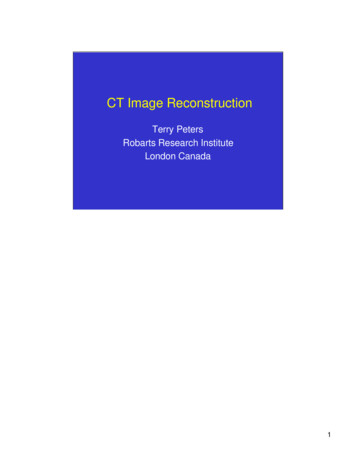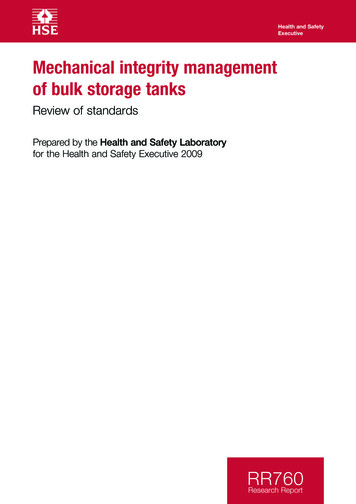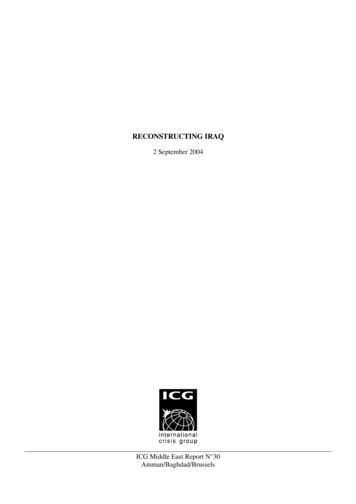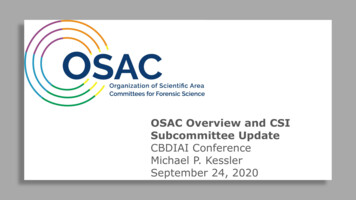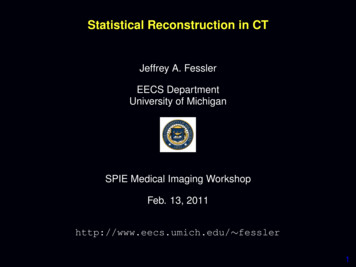
Transcription
UnitedStatesHistoryMI OPEN BOOK PROJECTReconstruction to TodayKimberly Eikenberry, Troy Kilgus, Adam Lincoln, KimNoga, LaRissa Paras, Mark Radcliffe, Dustin Webb,Heather Wolf
The text of this book is licensed under a Creative CommonsNonCommercial-ShareAlike (CC-BY-NC-SA) license as part ofMichigan’s participation in the national #GoOpen movement.This is version 1.4 of this resource, released August 2018Information on the latest version and updates are available on the projecthomepage: tion-NonCommercial-ShareAlike CC BY-NC-SA
The Michigan Open BookProjectAbout the Authors - United States History - Reconstruction - TodayKimberly EikenberryGrand Haven High SchoolGrand Haven Area Public SchoolsKim has a B.A. in History and Social Studies and a M.A. in Educational Leadership, both fromWestern Michigan University. She has served in many roles during her thirteen years as aneducator, including department chair, curriculum director, and administrator. Kim currentlyteaches World History and Economics at Grand Haven High School.Project Manager: Dave Johnson, WexfordMissaukee Intermediate School DistrictHS US Team Editor: Rebecca Bush, OttawaArea Intermediate School DistrictAuthorsKimberly Eikenberry, Grand Haven PublicSchoolsTroy Kilgus, Standish-Sterling SchoolsAdam Lincoln, Ithaca SchoolsTroy KilgusStandish-Sterling Central High SchoolStandish-Sterling Community SchoolsTroy Kilgus serves as the high school social studies chair at Standish-Sterling Central HighSchool. In his eight years of teaching, he has taught various social studies courses including AP US History and multiple levels of French. Mr. Kilgus earned his undergraduate degree in French Education and his Masters in Teaching from Saginaw Valley State University.Kim Noga, Ionia Public SchoolsLaRissa Paras, Greenville Public SchoolsMike Radcliffe, Greenville Public SchoolsDustin Webb, Lake City Area SchoolsHeather Wolf, Shepherd Public SchoolsAdam LincolnIthaca Jr/Sr High SchoolIthaca SchoolsAdam began his teaching career at Cadillac High School in Cadillac, Michigan where he taughtUS History, Global Studies, and AP World History. After 7 years, he moved back home to centralMichigan to teach at Ithaca Public Schools. While his main charge has been teaching WorldHistory and starting the AP World History program, Adam also teaches 8th Grade History, USHistory, History in Popular Culture and all sorts of computer science classes. Adam coachesModel United Nations, and runs the Jumbotron at Ithaca Community Stadium during events.Adam has served as a member of the Michigan Council for the Social Studies for over a decadeand has worked to unite his twin passions of Social Studies and effectively integratingtechnology into the classroom. Outside of school, Adam has served on the Content AdvisoryCommittee, as a Social Studies item writer for the Department of Education, and worked for thePASST project. Adam teaches History and Social Studies methods classes at Alma College asadjunct faculty. Apart from the world of education, Adam enjoys spending time with his familyespecially traveling on new adventures.
Kim NogaIonia Public SchoolsIonia High SchoolKim has a B.A. in History/ Social Studies and an M.A. in Curriculum and Teaching, bothfrom Michigan State University. For the past 14 years she has been employed at IoniaHigh School where she teaches Economics, U.S. History, and Humanitarian Studies. Herhobbies include reading and traveling the world.LaRissa ParasGreenville High SchoolGreenville Public SchoolsLaRissa is an alumni of Central Michigan University and the State University of New York.She is a tenured teacher in New York and now in Michigan where she works and resideswith her husband and two rambunctious boys. Currently she is teaching World History andCurrent Issues at Greenville High School. She and her husband founded LP Inspire, LLCto encourage young people to grow into their best selves. She is also the proud creator ofThe Lotus Project, a successful mentoring program to help young women become empow-Mike RadcliffeGreenville High SchoolGreenville Public SchoolsMike Radcliffe is a native of South Lyon, Michigan. He received his Bachelor of Artsdegree in history from Colorado State University, followed by a Masters of Arts degreein American Studies from the University of Colorado. Over his 23 years of teaching students in Colorado and Michigan, he has taught Advanced Placement United StatesHistory, American Popular Culture, World History, World Geography, Sociology, andEconomics. He currently serves as the department chair for the social studies department at Greenville High School, where he has taught the past 15 years. His previoustextbook projects include serving as a teacher consultant for textbooks in US Historyand World Geography for Teachers Curriculum Institute. His interests include his wife
The Michigan Open Book Project Team wouldlike to thank the following individuals for theirhelp in reviewing some content in the book andguiding the development process.Dustin WebbLake City High SchoolLake City Area SchoolsBiography Coming Soon!Eric Hemenway - Director of Repatriation, Ar chives and Records, Little Traverse Bay Bands ofOdawa IndiansJim Cameron, Michigan Department of Educa tionMelissa Kieswetter, Michigan Department ofHeather WolfShepherd Public SchoolsShepherd High SchoolHeather has taught Social Studies at Shepherd High School for 16 years. She currentlyteaches American History and Law, but has also taught Modern American History, Civics,Current Events, and History of American Wars in the past. Heather is a graduate of CentralMichigan University, where she earned both her undergraduate degree, as well as a Masterof Arts in History. She also teaches Social Studies Methods and Pre-Student Teachingcourses at CMU. Heather also is the chair of the Social Studies Department at ShepherdHigh School and is involved in many other facets of the school and community. Heatherwas named 2009 High School Educator of the Year by the Michigan Council for the SocialStudies. She enjoys reading, traveling and spending time with her family.Rebecca BushInstructional ConsultantOttawa Area Intermediate School DistrictRebecca Bush is currently the Social Studies Consultant at the Ottawa Area IntermediateSchool District (OAISD), where she assists K-12 social studies teachers in developing curriculum, modeling instructional strategies in social studies literacy, and designing districtlevel formative and summative assessments. Additionally, as Project Director, she has written and received multiple Teaching American History grants, working with teachers throughout an eight-county radius. She has presented at various national conferences on multipletopics surrounding social studies instruction as well as innovative techniques and topics informative and summative assessment design. Currently she is Co-Project Director of ThePerformance Assessments of Social Studies Thinking (PASST) Project and assists with theprofessional development of teacher writers for the MI Open Book Project where she servesas an editor of several of the project’s texts. Rebecca currently leads the Michigan Social
Chapter 3How successful was theU.S. in balancing theideals of democracywith those ofimperialism as Americabecame a world power?1. Why were the 1890s a turning point in American foreign policyhistory?2. To what degree was American expansion in the 1890s acontinuation of manifest destiny? To what degree wasexpansion in the 1890s a change from previous expansion?3. What were the causes and consequences of the SpanishAmerican War?4. What challenges did America face in governing an empire?5. Were Wilson’s 14 Points idealistic or realistic?How did America’s response to WWI challenge the concept ofthe American dream and change what it meant to be an“American”?
Section 1Imperialistic PursuitsQUESTIONS TO GUIDE INQUIRYAs progressives worked for domestic reform in political, economic, and social1. Why were the 1890s a turning point inAmerican foreign policy history?matters, others focused on and pushed for U.S. expansion overseas. American2. To what degree was American expansion inthe 1890s a continuation of manifestdestiny? To what degree was expansion inthe 1890s a change from previousexpansion?3. What were the causes and consequencesof the Spanish-American War?4. What challenges did America face ingoverning an empire?TERMS, PLACES, PEOPLEImperialism was partly rooted in 'American exceptionalism,' the idea that theUnited States was different from other countries due to its specific world missionto spread liberty and democracy. While many Americans favored imperialisticendeavors, others wondered if the contradiction to democratic ideals was toolarge of a gamble in the area of foreign affairs.“JUSTICE TOWARDS ALL NATIONS”As George Washington bid farewell as President in 1793 amidst the turbulence ofthe French Revolution overseas, he provided the young country with some fatherlywisdom regarding relationships—specifically, the “great rule of conduct” ofrelationships between the U.S. and foreign powers in general: “Observe goodAlfred Thayer Mahanfaith and justice towards all nations; cultivate peace and harmony with all. . . . Itannexationwill be worthy of a free, enlightened, and at no distant period, a great nation, toFrederick Jackson TurnerImperialismgive to mankind the magnanimous and too novel example of a people alwaysguided by an exalted justice and benevolence.“Queen LiliuokalaniSanford B. DoleTariffsTheodore Roosevelt75
“ Just and amicable feelings towards all should becultivated. . . ““. . . Europe has a set of primary interests which to us havenone; or a very remote relation. Hence she must be engagedin frequent controversies, the causes of which are essentiallyforeign to our concerns.”--George Washington’s Farewell Address, 1796In Washington’s eyes, friendly trade relations with foreigncountries was the goal, but playing favorites through politicalalliances that could needlessly drag the young nation intoEurope’s seemingly endless cycles of imperial war and dramawould need to be avoided.U.S. Expansion in North America is republished with permission ofStratfor.Geography played an important role in America’s development.By the early 1900s, French ambassador Jules Jusserand notedacross the North American continent, acquiring a path to thethat the United States was “blessed among nations .On thePacific Ocean through negotiation, purchase, war and conquest.north she had a weak neighbor; on the south, another weakUnbeknownst to Washington, the following century would see theneighbor; on the east, fish, and on the west, fish.”United States flourish at an unimagined rate, thanks in large partWashington had every reason to view those controversies asforeign since, in terms of its geography, the young country hadtremendous capacity for growth. Geographically, the youngdue to a geography that left it with seemingly unlimited naturalresources, two vast oceans, and relatively few obstacles involvinggreater foreign powers.nation took full advantage of the vast territory to its west. Thecentury that followed saw an America that rapidly expanded76
For the better part of the following century, the United States wasEach new territory acquired by a foreign power within the watersable to adhere to Washington’s advice in regards to relationshipssurrounding the United States was a potential threat to Unitedoverseas, despite the turbulence of war with Great Britain in theStates security and economic interests. And as European powersnew nation’s early “teen years”. However, the late nineteenthbegan to troll the Pacific and Caribbean for large trophies to addcentury found the country jealously watching the great empires ofto the economic and strategic might of their empires, AmericaEurope carve out large territories of control and influence infound itself racing to compete. The influence of America’sAfrica, Asia, and the Pacific, and the siren call of empire becameinternational peers overseas proved too great, and Washington’sirresistible. This policy of extending political, economic, andearnest warning to avoid Europe’s influence, fell upon deaf ears.military control over other nations became known as imperialism.REDEFINING AMERICAN FOREIGN POLICYThroughout the past century, historians have often debated theprimary causes of America’s shift away from Washington’s foreignpolicy ideals toward the overseas pursuit of building an empire.While opinions still differ on whether America stumbled upon theprocess of building an empire or actively pursued the creation ofone, few would challenge the significant impact that America’sterritorial expansion would have on its emergence as a m.jpg77
expansion begun in the colonial cradles of Jamestown andPlymouth, the patterns of territorial acquisition following theCivil War were significantly different from the acquisition ofterritories before the war. Prior to the Civil War, settlersgenerally migrated westward across the continent in pursuit ofrich, fertile soil. New lands were frequently adjacent to existingU.S. territory and, despite the presence of smaller tribes ofNative Americans, were perceived to be sparsely populated andopen for settlement. When enough settlers had arrived in aparticular area, the territory could then apply for statehood andenter the United States as a state equal with its colonialpredecessors. Upon admission, the Inhabitants were thenconsidered citizens of the United States. Territories in the OldNorthwest, the Louisiana Purchase, Florida, Texas, andCalifornia had followed this pattern, as did the land acquiredCartoon Analysis:from Mexico (Arizona and New Mexico).1. What is the main argument presented by the cartoonist?2. What evidence does the cartoonist present for his argument?3. Is the argument convincing? Why or why not?Post-Civil War Settlement Patterns However, lands acquiredfollowing the Civil War tended to be island possessions awayfrom the mainland United States that were desirable for strategicand economic reasons, such as naval bases, coaling stations,Early Settlement Patterns While historians in the twentieth centurydeveloped differing interpretations as to whether the expansion of theUnited States was “a great aberration” from previous periods ofexpansion, or was simply a continuation of patterns ofand trading ports along major shipping lanes. Whereas pre-CivilWar land acquisition reflected the resource needs of an agrariansociety, post-War expansion reflected the needs and desires ofan industrial society seeking access to economic markets in78
heavily-populated, foreign lands. The new lands were viewed asoutput had far outstripped the capacity of the American public tocolonies to be possessed, with little regard for future statehood orpurchase its goods. As quantities of goods remained unsold,potential citizenship for its settled populations.prices fell, as did profits. Employment rose and fell with thefortunes of business. The economic challenges ofInteractive 3.1Characteristics ofExpansionoverproduction in an industrial economy resulted in severaldifficult financial crises throughout the late 1800s, includingsignificant depressions in the years 1873-1878, 1882-1885, and1893-1897 (the country’s worst until the Great Depression of the1930s). [4] Railroads, which had driven much of America’scorporate growth, found themselves plagued by overexpansionand facing bankruptcy. With virtually half of the last twenty-fiveyears of the nineteenth century mired in economic uncertainty,social unrest in America increased.Determine which of the followingcharacterize American expansionprior to 1865, and which onescharacterize Post-Civil Warexpansion.Labor Unrest As workers fell upon hard times financially, laborunrest exploded in a series of violent strikes, forcing businessleaders to conclude that new markets overseas for Americangoods were necessary before the American ship of state sank likeAMERICA LOOKS OVERSEASa stone amidst the stormy waves of economic crisis.Problems with the Industrial Economy Throughout much of thenineteenth century, American industry grew rapidly and profitedgreatly from America’s vast natural resources, steady stream ofimmigrant labor, and technological advances in agriculture andindustry. However, by the late 1800s, rapid gains in productivityhad produced a new problem--America’s domestic markets for itsproducts were saturated. American industrial and agricultural79
How might images such as these in weekly news magazinesinfluence public opinion? How might these events be viewedby Businessmen? Workers? The Middle Class?The Disappearing Frontier and Need for New MarketsCompounding the troubling situation domestically was theUnited States Census Bureau’s 1890 announcement that theWestern frontier was no longer distinguishable from settled areas.Homestead Steel Strike, mgId 1-2-10DAHistorian Frederick Jackson Turner argued that the Americancharacter, innovation anddemocracy had been profoundlyshaped by the frontier, and itsInteractive 3.2 The FrontierThesisdisappearance would pose achallenge to America’s future. Withpotential settlement and futuremarkets within the country’sborders limited, “new frontiers” andmarkets in Latin America and Asiabecame financially attractive forAmerica’s excessive agriculturalFor more on the Turner Thesis,click hereand industrial products.80Striking workers fire on Pinkertons at Andrew Carnegie’s Homestead Steel Plant
Technological AdvancesOverseas markets became an option in the nineteenth centurydue to significant advances in communications andtransportation technology. Since the 1830s, steamships hadgreatly reduced the time necessary to reach distant ports in suchfaraway places as Hong Kong, Manila, Hawaii, and China.Communications developments such as telegraphs, telephones,and undersea cables further improved the information flowinternationally, thereby assisting in raising public awareness andcuriosity about lands previously absent from the publicimagination.Today, many Americans are exposed to foreign cultures throughtelevision, movies, and the internet. For many Americans in thelate 19th century, their first exposure to foreign cultures camethrough seeing the world through a stereoscope.Interactive 3.3 America onthe MoveTo learn more on AmericanTransportation history, click here81
Christian Missionseconomic interests overseas.As more people became aware of those distant shores, theThe Influence of Alfred Mahan Of course, in order to protectmissionary impulse to bring the message of Protestantthose markets and America’s economic interests abroad, a strongChristianity to regions like Hawaii and China increased as well.navy was necessary, especially among nations that began to seeChristian missionaries sought to improve the lives of nativethe lessons of the biological world of Charles Darwin and thepopulations by bringing Christianity, education, medicine, andsocial world of Herbert Spencer in terms of “survival of themodernization to distant populations.fittest”—Life among the nations was a continuous struggle forexistence, and much like the biological world, the strongestRacial Superioritynations would survive and dominate the weaker ones. In a worldSome expansionists, such as Josiah Strong, were strongly drivenby the idea that the Anglo-Saxon race was superior to all others.As the superior race,where ideas have consequences, Naval Academy graduate AlfredThayer Mahan became the man who provided the rationale forAmerican empire (in addition to the rationale for the naval buildupin Europe that contributed to World War I), and a powerful navy toStrong argued thatback it. In a series of several books, including The Influence ofAmerica had a moralSea Power upon History, 1660-1783 (1890), Mahan argued thatresponsibility to fulfill asea power was essential to national greatness, and that greatnessdivinely-appointedwas dependent upon a highly productive industrial economy, adestiny of bringing thelarge fleet of ships engaged in the “carrying trade,” a powerful,blessings of liberty andmodern navy to protect the merchant ships, and colonies thatChristianity to lesscould provide strategic naval bases, foreign markets for products,enlightened races.and essential raw materials. Mahan’s ideas heavily influencedSuch ideas werepolicy makers across America and the Atlantic, including theblended into thefuture Assistant Secretary of the Navy and President of the Unitedperiod’s economicStates, Theodore Roosevelt. Among Mahan’s solutions to helparguments to furtherAmerica win the competitive struggle of the nations: Buildpromote the expansionstrategic military bases in the Caribbean and the Pacific to guardof democratic andhttps://www.loc.gov/item/ggb2005023626/82
the canal and American interests from European encroachment,Marketsgain control of Hawaii and other islands along key trade routes inthe Pacific, and construct a canal across the isthmus of CentralNew outlets for manufactured products, services, or rawAmerica. When Mahan’s book was published, the American Navymaterials; access to foreign goods necessary to meet consumerwas ranked twelfth in the world. By the end of the 1890s, thedemandUnited States was firmly anchored at number three. Ultimately,America was not the only country heavily influenced by Mahan’swritings. The European powers and Japan were persuaded aswell, leading to a military arms race that would culminate in twoworld wars.Below are a list of common foreign policy priorities of presidentsover the ages. The year is 1896 and you are President of theUnited States. As you consider the social, economic, andNational SecurityActions taken to protect the country from foreign threatsRaw MaterialsAcquisition of food, ports, or other natural resourcesIdeologypolitical state of the nation, what would be your top three biggestTo spread political, religious, or economic ideas (or to stop theforeign policy priorities? Justify your answer. What should be ourspread of them in other areas)top priorities today?National UnityTo develop, promote, or maintain a sense of national identity byuniting Americans against a hostile, external group or forceHumanitarianismSelf-DeterminationThe desire to liberate a group or nation of people from theinfluence and domination of anotherNational Prestige or PrideThe desire for more power or influence among other nations,To promote justice and stability globally through relief efforts,which may include the desire to overcome a previous loss orquality of life improvements, reduction in human trafficking, or tohumiliationstop the actions of an aggressive/oppressive country againstanotherSEEDS OF AN AMERICAN EMPIRE83
Seward’s Vision American expansion into the Pacific took rootHawaiiseveral decades earlier under Abraham Lincoln and AndrewJohnson’s Secretary of State, William Seward. As an earlyHawaii was also a key to Seward’s vision of empire, although heexpansionist who envisioned a vast commercial empire thatwas unsuccessful in negotiating economic treaties with the islandincluded Canada, Mexico, the Pacific, and Latin America, Sewardnation. Known as the “Crossroads of the Pacific,” Hawaii wasand others like him saw the trade routes and markets of Chinastrategically located in the heart of the Pacific and served as aand Asia as a significant key to American prosperity, in addition tovital port for whaling and merchant ships. Naval strategistsa canal across Latin America that was protected by strategicvalued its harbors, and it was perfectly situated to guard theisland bases in the Caribbean. In order to orient Americanapproaches of any canal that might be built in Central America.economic ties westward, Seward managed to annex theChristian missionaries had first arrived on the island in 1820, anduninhabited Midway Islands northwest of Hawaii in 1867.new settlers soon followed, as did American business investorswho felt sugar cane could grow heartily in the Hawaiian climate.Alaska That same year, Seward encouraged a reluctant U.S.They were not disappointed. Soon, sugar cane became theCongress to approve the purchase of Alaska from Russia for 7.2heart of the Hawaiian economy. By the 1870s and 1880s,million, which wouldeconomic treaties were signed between Hawaii and theprovide the UnitedUnited States that allowed Hawaiian sugar, an industryStates with fish, furs,which soon came to be dominated by American planters, toand coaling stationsbe sold in the United States duty-free. This had been donefor merchant ships inin exchange for a Hawaiian pledge that no other nationthe Pacific. Whilewould be able to lease or acquire Hawaiian territory or bemany regarded Alaskagranted special economic privileges. To protect Americanas “Seward’s Icebox”trade and provide a strategic military base in the Pacific,and “Seward’s Folly,”America further negotiated a naval base at Pearl Harbor.the sentiments wereHowever, by 1890, the economic fortunes of Hawaiian sugarquickly forgotten bytook a dramatic twist. That year, tariffs went into effect thatthe time gold wasmade Hawaiian sugar more expensive in the United States.discovered in the Yukon.A tariff is a special tax placed on imported goods. Because84
Hawaiian sugar had become so dependent upon AmericanBy January of 1893, American planters responded. Outraged bymarkets, the Hawaiian economy crashed, and unemploymentthe queen’s quest to keep Hawaii independent, the whiteskyrocketed among the large numbers of Chinese and JapaneseAmerican planters revolted against Liliuokalani’s authority in aimmigrants who worked the cane fields and sugar mills. In anbloodless coup. An intimidating force of 150 U.S. Marines, calledeffort to re-assert political control over an island nation that wasin by U.S. Ambassador John L. Stevens in response to planters’increasingly being dominated by a minority group of Americanrequests to “protect American lives and property", were lined upplanters, in 1891 the Hawaiian queen Liliuokalani began callingoutside of the royal palace with Gatling guns. Queen Liliuokalanifor a “Hawaii for the Hawaiians” that constitutionally restricted thesurrendered her throne to “the superior force of the Unitedpolitical power of U.S. planters in favor of native Hawaiians.States,” in the hopes that she would be reinstated once leaders inWashington, D.C. investigated how her throne had beenoverthrown. A provisional government was immediatelyestablished with Sanford B. Dole, a Hawaiian-born son ofAmerican-born missionaries, as president. Stevens, sensing anopportunity for the United States to take over control of theislands, famously cabled back to Washington, "The Hawaiianpear is now fully ripe, and this is the golden hour for the UnitedStates to pluck it." The provisional government submitted atreaty for annexation into the United States. President GroverCleveland, however, refused to seek annexation of the islandsand had U.S. troops removed, believing Liliuokalani’s overthrowto be illegal and an “act of war.” When Cleveland soughtLiliuokalani’s restoration to the throne, the white planters refused.Hawaii's Queen Liliuokalani in 189185
Instead, they drafted a constitution and proclaimed the birth ofthe new Republic of Hawaii, with Dole as its first president.Interactive 3.4 The Impactof AnnexationInteractive 3.5 Hawaii’sStoryDespite native Hawaiian opposition, the republic would not haveto wait long to gain admission to the United States, however, asthe outbreak of the Spanish-American War on the island of Cuba5,000 miles away would soon cause President William McKinleyto support Hawaii’s annexation in 1898.To view the impact of annexationfrom the Hawaiian perspective,click hereRead Queen Liliuokalani's ownstory hereJohn Gast's American Progress, 1872To what extent was American expansion in the 1890s aThe United States flag is raised over the ʻIolani Palace In Honolulu after the annexation of Hawaiicontinuation of manifest destiny in the 1840s?86
Section 2The Spanish-American WarQUESTIONS TO GUIDE INQUIRY1. Why were the 1890s a turning point inAmerican foreign policy history?2. To what degree was American expansion inthe 1890s a continuation of manifestdestiny? To what degree was expansion inthe 1890s a change from previousexpansion?3. What were the causes and consequencesof the Spanish-American War?4. What challenges did America face ingoverning an empire?TERMS, PLACES, PEOPLEYellow 700/28700v.jpgReconcentrationJingoCuba had found itself alongside Puerto Rico, the Philippines and Guam as the onlyTeller Amendmentremaining colonies of the once vast Spanish Empire that had rose to prominenceRough Riderswith Columbus’s discovery of the New World in 1492.87
Cubans Seek Independence As Hawaiian planters discovered,the world was becoming much more interconnected in thenineteenth century, and connections with American marketscould come with a steep price. Cuba’s reliance on US marketsfor its sugar produced a situation similar to what Hawaiiexperienced only a few years earlier. Located 90 miles off theFlorida coast, Cuba was home to a native population that hadtried unsuccessfully to free itself from the colonial grip of Spain.However, Cuba was also home to the largest share of Americaninvestments overseas, with American business interests deeplyinvolved in Cuban sugar and tobacco plantations, miningoperations, business properties, and residences. Sugar plantersin Cuba had also teamed up with American sugar planters in theUnited States to encourage Congress to pass tariff protectionson Cuban sugar, at the expense of Hawaiian sugar. Now, only afew years later, Cuba found itself holding the short end of thestick when the U.S. Congress passed a tariff in 1894 thateliminated the special economic be
US History, Global Studies, and AP World History. After 7 years, he moved back home to central Michigan to teach at Ithaca Public Schools. While his main charge has been teaching World History and starting the A

